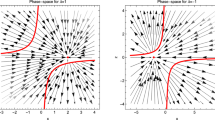Abstract
We develop a systematic approach to construct novel completely solvable rational potentials. Second-order supersymmetric quantum mechanics dictates the latter to be isospectral to some well-studied quantum systems. \( \mathcal{P}\mathcal{T} \) symmetry may facilitate reconciling our approach to the requirement that the rationally extended potentials be singularity free. Some examples are shown.
Similar content being viewed by others
References
C M Bender and S Boettcher, Phys. Rev. Lett. 80, 5243 (1998)
A Mostafazadeh, J. Math. Phys. 43, 205 (2002)
F Cooper, A Khare and U Sukhatme, Phys. Rep. 251, 267 (1995)
G Junker, Supersymmetric methods in quantum and statistical physics (Springer, Berlin, 1996)
B Bagchi, Supersymmetry in quantum and classical physics (Chapman and Hall/CRC Press, Boca Raton, FL, 2000)
B Mielnik and O Rosas-Ortiz, J. Phys. A37, 10007 (2004)
B Mielnik, J. Math. Phys. 25, 3387 (1984)
C V Sukumar, J. Phys. A18, 2917 (1985)
A Contreras-Astorga and D J Fernández, J. Phys. A41, 475303 (2008)
A A Andrianov, M V Ioffe, F Cannata and J-P Dedonder, Int. J. Mod. Phys. A10, 2683 (1995)
A A Andrianov, M V Ioffe and D N Nishnianidze, Theor. Math. Phys. 104, 1129 (1995)
A A Andrianov, M V Ioffe and D N Nishnianidze, Phys. Lett A201, 103 (1995)
B F Samsonov, Mod. Phys. Lett. A11, 1563 (1996)
B Bagchi, A Ganguly, D Bhaumik and A Mitra, Mod. Phys. Lett. A14, 27 (1999)
D J Fernández and C N Fernández-García, AIP Conference Proceedings 744, 236 (2005)
D Gómez-Ullate, N Kamran and R Milson, An extension of Bochner’s problem: Exceptional invariant subspaces, arXiV:math-ph/0805.3376
D Gómez-Ullate, N Kamran and R Milson, An extended class of orthogonal polynomials defined by a Sturm-Liouville problem, arXiV:math-ph/0807.3939
C Quesne, J. Phys. A41, 392001 (2008)
D Gómez-Ullate, N Kamran and R Milson, J. Phys. A37, 1789 (2004)
D Gómez-Ullate, N Kamran and R Milson, J. Phys. A37, 10065 (2004)
L E Gendenshtein, JETP Lett. 38, 356 (1983)
Such a picture is also valid whenever the parameters vary in the range A + 1 > B > A + ½ > ½ or A + ½ > B > A > 0, where the potential is weakly attractive at the origin. Among the two square integrable solutions of the Schrödinger equation corresponding to a given E (A)ν , it is customary to consider the function (3) as the physical one because it is the most regular
V Bargmann, Rev. Mod. Phys. 21, 488 (1949)
A Mitra, P K Roy, A Lahiri and B Bagchi, Int. J. Theor. Phys. 28, 911 (1989)
G Junker and P Roy, Phys. Lett. A232, 155 (1997)
M Abramowitz and I A Stegun, Handbook of mathematical functions (Dover, New York, 1965)
B Bagchi and C Quesne, Phys. Lett. A273, 285 (2000)
B Bagchi and C Quesne, Phys. Lett. A300, 18 (2002)
B Bagchi, S Mallik and C Quesne, Int. J. Mod. Phys. A17, 51 (2002)
Z Ahmed, Phys. Lett. A282, 343 (2001)
Z Ahmed, Phys. Lett. A287, 295 (2001)
G Lévai and M Znojil, J. Phys. A33, 7165 (2000)
G Lévai, F Cannata and A Ventura, Phys. Lett. A300, 271 (2002)
A Sinha and R Roychoudhury, Phys. Lett. A301, 163 (2002)
B Roy and R Roychoudhury, Mod. Phys. Lett. A19, 2279 (2004)
Author information
Authors and Affiliations
Corresponding author
Rights and permissions
About this article
Cite this article
Bagchi, B., Quesne, C. & Roychoudhury, R. Isospectrality of conventional and new extended potentials, second-order supersymmetry and role of \( \mathcal{P}\mathcal{T} \) symmetry. Pramana - J Phys 73, 337–347 (2009). https://doi.org/10.1007/s12043-009-0126-4
Published:
Issue Date:
DOI: https://doi.org/10.1007/s12043-009-0126-4




